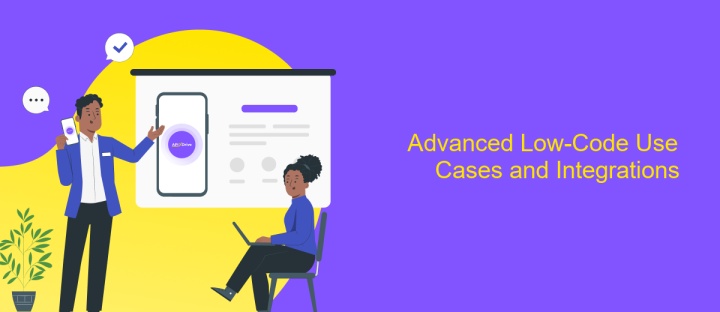Low-Code Examples
In today's rapidly evolving digital landscape, low-code development platforms are revolutionizing how applications are built and deployed. These platforms empower users to create robust software solutions with minimal hand-coding, significantly accelerating the development process. This article explores various low-code examples across industries, highlighting their impact on streamlining operations, enhancing productivity, and driving innovation in an increasingly competitive market. Discover how low-code is transforming the way we approach software development.
Introduction to Low-Code and its Benefits
Low-code development is revolutionizing the way applications are created by minimizing the need for extensive coding. This approach allows developers and non-developers alike to build applications using graphical interfaces and pre-built templates. As businesses strive for agility and faster time-to-market, low-code platforms have emerged as a powerful solution, streamlining the development process and reducing dependency on specialized coding skills.
- Accelerated Development: Low-code platforms significantly speed up the development cycle, enabling quicker deployment of applications.
- Cost Efficiency: By reducing the need for extensive coding, businesses can save on hiring specialized developers, thus cutting down costs.
- Enhanced Collaboration: These platforms facilitate better collaboration between IT and business teams, ensuring that applications align closely with business needs.
- Flexibility and Adaptability: Low-code solutions allow for easy modifications and updates, making it simpler to adapt to changing business requirements.
The rise of low-code platforms marks a significant shift in software development, democratizing the process and making it accessible to a wider audience. By leveraging these benefits, organizations can innovate faster and remain competitive in a rapidly evolving digital landscape. As more businesses embrace this approach, the potential for growth and innovation becomes virtually limitless.
Real-World Low-Code Examples Across Industries

Low-code platforms are revolutionizing industries by enabling faster and more efficient application development. In the healthcare sector, for instance, low-code solutions are being used to create patient management systems that streamline operations and enhance patient care. These platforms allow healthcare providers to quickly adapt to regulatory changes and integrate new technologies without extensive coding knowledge. By using low-code, healthcare organizations can improve data management and reduce administrative burdens, ultimately leading to better patient outcomes.
In the financial industry, low-code platforms are transforming the way institutions handle complex processes such as loan approvals and risk assessments. By leveraging tools like ApiX-Drive, financial companies can easily integrate various services and automate workflows, reducing manual errors and improving efficiency. This adaptability is crucial in a sector where speed and accuracy are paramount. Additionally, low-code solutions support rapid prototyping and deployment, allowing financial institutions to respond swiftly to market changes and customer demands, maintaining a competitive edge.
Building Simple Applications with Low-Code Platforms

Low-code platforms have revolutionized the way individuals and businesses approach application development. By minimizing the need for extensive coding knowledge, these platforms empower users to create applications with intuitive drag-and-drop interfaces and pre-built modules. This democratization of app development allows a broader range of people to participate in the creation process, enabling faster and more efficient solutions to everyday problems.
- Identify the problem you want to solve or the process you wish to streamline.
- Select a suitable low-code platform that aligns with your requirements and technical skills.
- Use the platform's visual interface to design your application, utilizing pre-built components and templates.
- Integrate necessary data sources and configure workflows to ensure seamless functionality.
- Test the application thoroughly to identify any issues or areas for improvement.
- Deploy the application and gather user feedback for continuous enhancement.
By following these steps, even those with minimal technical expertise can build functional applications that address specific needs. Low-code platforms not only accelerate the development process but also foster innovation by allowing more people to bring their ideas to life. This approach is transforming industries by making technology more accessible and adaptable to changing demands.
Advanced Low-Code Use Cases and Integrations

As businesses increasingly adopt low-code platforms, advanced use cases and integrations are emerging, enabling more sophisticated applications. These platforms now support complex workflows and processes, allowing organizations to streamline operations and enhance customer experiences. By leveraging low-code solutions, companies can rapidly develop applications that integrate seamlessly with existing systems.
One significant advantage of low-code platforms is their ability to integrate with a wide range of third-party services and APIs. This capability empowers businesses to create comprehensive solutions that incorporate various functionalities without extensive coding. As a result, organizations can focus on innovation and growth while reducing development time and costs.
- Automated business process management
- Integration with AI and machine learning models
- Real-time data analytics and visualization
- Cross-platform mobile application development
These advanced use cases highlight the potential of low-code platforms to transform traditional development approaches. By facilitating seamless integrations and supporting complex functionalities, low-code solutions enable businesses to adapt quickly to changing market demands. As technology evolves, the capabilities of low-code platforms will continue to expand, offering even greater opportunities for innovation.
The Future of Low-Code Development and its Impact
The future of low-code development promises to revolutionize the way businesses approach software creation. As technology continues to evolve, low-code platforms are becoming more sophisticated, enabling organizations to build complex applications with minimal coding expertise. This democratization of software development empowers non-technical users to actively participate in the creation process, leading to increased innovation and faster time-to-market. Moreover, low-code solutions are expected to integrate seamlessly with artificial intelligence and machine learning, further enhancing their capabilities and expanding their potential applications across various industries.
One significant impact of low-code development is its ability to streamline integrations with existing systems and services. Platforms like ApiX-Drive facilitate these integrations by offering user-friendly interfaces that connect diverse applications without the need for extensive coding. This capability not only reduces the workload for IT departments but also enables businesses to adapt quickly to changing market demands. As low-code development continues to gain traction, its influence will likely extend beyond traditional software development, transforming operational processes and fostering a culture of continuous improvement in organizations worldwide.
FAQ
What is Low-Code development?
Can Low-Code platforms be used for automation?
How can Low-Code help with integration tasks?
Is Low-Code suitable for complex enterprise applications?
What are some examples of tasks that can be automated using Low-Code?
Apix-Drive is a universal tool that will quickly streamline any workflow, freeing you from routine and possible financial losses. Try ApiX-Drive in action and see how useful it is for you personally. In the meantime, when you are setting up connections between systems, think about where you are investing your free time, because now you will have much more of it.

